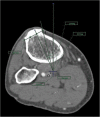Tibiofemoral rotation alignment in the normal knee joints among Chinese adults: a CT analysis
- PMID: 32446307
- PMCID: PMC7245925
- DOI: 10.1186/s12891-020-03300-7
Tibiofemoral rotation alignment in the normal knee joints among Chinese adults: a CT analysis
Abstract
Background: Consensus on tibial rotation in total knee arthroplasty (TKA) remains controversial. The present study aimed to investigate the closest anatomical reference to surgical epicondylar axis (SEA) among 10 tibial markers in Chinese adults.
Methods: This study included examination of 122 normal lower extremities. Briefly, 10 axes were drawn on the axial sections: transverse axis of tibia (TAT), axis of medial edge of patellar tendon (MEPT), axis of medial 1/3 of patellar tendon attachment (M1/3), Akagi line, Insall line, axis of medial border of tibial tubercle (MBTT), and axis of anterior border of the tibia 1-4 (ATC1-4). The mean angles between TAT and SEA and that between other axes and the line perpendicular to SEA were measured. Pairwise differences among the 10 tibial axes were examined by applying one-way analysis of variance (ANOVA) and paired t-test.
Results: In all the knees, the mean angles of M1/3, Akagi line, Insall line, MBTT, ATC1, ATC2, ATC3, and ATC4 axes were compared to the line perpendicular to the projected SEA and found to be 10.2 ± 5.1°, 1.4 ± 5.0°, 11.9 ± 5.4°, 3.6 ± 4.8°, 12.0 ± 6.9°, 7.2 ± 8.6°, 7.1 ± 10.4°, and 6.6 ± 13.5° external rotation, respectively, and the MEPT axis was 1.6 ± 4.5° internal rotation. The mean angle for TAT was 4.1 ± 5.3° external rotation. The M1/3 and Insall line were significantly more externally rotated than Akagi line, MEPT, MBTT, TAT, ATC2, ATC3, and ATC4 axes. No significant differences were noted between the TAT axis and the MBTT axis and among the ATC2, ATC3, and ATC4 axes.
Conclusion: The Akagi line, MBTT, and TAT showed good consistency with SEA in the axial femorotibial alignment with knee in extension. The middle segment of the anterior tibial crest also demonstrated good alignment consistency with SEA for the axial femorotibial alignment. Hence, these markers can be used as reliable references for rotational alignment of the tibial component in TKA.
Keywords: Anatomic landmarks; Reference lines; Reliability; Rotational alignment; Tibial component; Total knee arthroplasty.
Conflict of interest statement
The authors declare no competing interests.
Figures











References
MeSH terms
Grants and funding
LinkOut - more resources
Full Text Sources
Medical

